5 Ways ERP Forecasting Can Improve Business Efficiency
Years ago, I was tasked with enhancing my employer’s ERP forecasting. It turned into a valuable learning experience It was an interesting learning experience. Some of the Greek words from college statistics classes began to make sense and a few even remained in my vocabulary. A mentor once shared a basic truth in any forecast, “they are always wrong”.
While forecasts will never be perfect, they can get remarkably close to reality with experience, effort, and the right demand forecasting tools or statistical software.
Forecasting through an ERP system typically uses historical data to identify trends that can be projected into the future. Since ERP systems are repositories of transactional data, they provide a solid foundation for informed predictions. But how does this translate into improved business efficiency? Here are five ways:
1. Demand Forecasting
What future orders can you expect? Forecasting demand helps businesses anticipate customer needs based on historical data and trends. With demand forecasting, you can predict orders by customer, product, or geography. For instance, identifying seasonal patterns enables better stock planning.
By combining ERP data with a CRM system, you can analyze your sales pipeline and predict which quotes are likely to convert into orders. The importance of demand forecasting cannot be overstated; it helps you align inventory with actual demand, reducing waste and missed opportunities.
What are the core KPIs for demand forecasting?
Focus on forecast accuracy, service levels, and inventory turnover rates. These metrics indicate how well your forecasting aligns with actual demand, helping you refine these processes.
Recommended Reading: ERP Software Guide - Compare ERP products with forecasting capabilities
2. Financial Forecasting
ERP forecasting allows you to predict revenue, costs, and capital needs, effectively serving as the backbone of financial planning. Using this data, businesses can create budgets and plan for future capital requirements based on production demands.
What is the difference a between financial forecast and a projection audit?
A financial forecast uses assumptions to predict outcomes, while a projection considers “what-if” scenarios based on conditional factors. Knowing this distinction ensures accurate reporting and decision-making.
Financial forecasting becomes especially critical in long-term projects. By predicting cost fluctuations and market shifts, you can ensure quotes and budgets are aligned with future realities. Understanding the nuances of financial forecast vs projection audits also ensures greater financial clarity and decision-making precision.
3. Job Scheduling
Although not traditionally seen as an ERP forecast, job scheduling systems rely heavily on predictive analytics. ERP software analyzes historical job data to predict the time and resources required for operations.
Knowing how long a task will take based on engineering standards or past performance eliminates bottlenecks in your workflow. Effective job scheduling tools also help synchronize production timelines, ensuring materials and components are available when needed without excess inventory.
What are some common methods for job scheduling?
Techniques like first-come-first-served, shortest processing time, and priority-based scheduling can significantly improve production efficiency when used with an ERP system.
Without ERP forecasting you cannot simply expect a production job to be at a work center at 10:14 PM and arrange for components to be on hand at exactly that moment.
4. Supply Forecasts
Analyzing your supply chain through an ERP system allows you to predict when materials will arrive and optimize procurement. By examining supplier lead times, past delivery data, and external factors like shipping schedules or labor strikes, you can make accurate predictions about delivery timelines.
What are the benefits of accurate demand forecasting?
Improved demand forecasting reduces inventory costs, minimizes supply chain disruptions, and enhances customer satisfaction by ensuring timely delivery.
The right supply chain forecasting tools and software enable businesses to reduce risks and improve planning. The importance of demand forecasting extends to ensuring production schedules are not disrupted due to material shortages.
5. External Forecast Integration
Beyond internal ERP data, integrating external datasets can significantly enhance your forecasting accuracy. For instance, government indices, economic indicators, and environmental forecasts such as El Niño predictions can offer valuable insights.
How does external data improve supply chain forecasting methods?
Incorporating external datasets helps businesses anticipate market shifts and environmental challenges, which are crucial for building resilient supply chain forecasting models.
Supply chain forecasting models that incorporate such external variables often provide a more robust framework for prediction. The use of modern demand forecasting methods ensures that businesses are not blindsided by market or environmental changes.
Why ERP Forecasting Matters
As Nobel laureate Nils Bohr once quipped, “Prediction is very difficult, especially if it’s about the future.” While perfect accuracy remains elusive, ERP forecasting bridges the gap between chaos and control, offering businesses a way to make informed, data-driven decisions.
For those still skeptical, just remember: even if the forecast is imperfect, it’s still a powerful tool to reduce uncertainty.
Free white paper
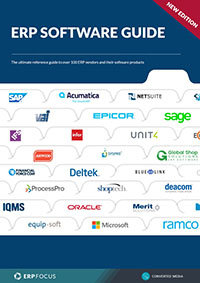
ERP Software Guide
A 70 page guide covering over 100 different software products
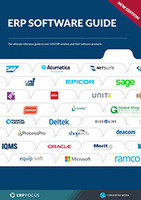
Featured white papers
-
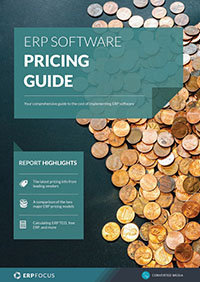
ERP Software Pricing Guide
Get the latest pricing information on over 80 popular ERP systems, and learn how to budget for your ERP project in our free guide
Download -
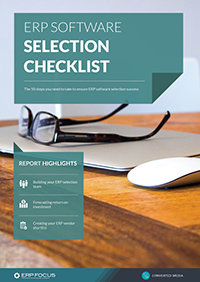
60-Step ERP Selection Checklist
Get the comprehensive checklist for your ERP selection project
Download -
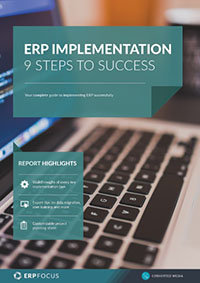
ERP Implementation: 9 steps to success
The 9 proven steps you should follow when implementing ERP
Download
Related articles
-
![Three direct links between ERP and manufacturing revenue [image by Snowing on Freepik] Three direct links between ERP and manufacturing revenue [image by Snowing on Freepik]](jpg/three%2bdirect%2blinks%2bbetween%2berp%2band%2bmanufacturing%2brevenue%2b%255bimage%2bby%2bsnowing%2bon%2bfreepik%255d2b6a.jpg)
Three direct links between ERP and manufacturing revenue
What you need to know to help you achieve a return on your manufacturing ERP investment
-

CMMC Compliance: What Aerospace and Defense Manufacturers Need to Know
Key insights on CMMC compliance, deadlines, and securing DoD contracts with CMMC 2.0 certificatio...
-

How to conduct a thorough ERP audit
The types of ERP audit, and step-by-step instructions on how to audit your ERP system

